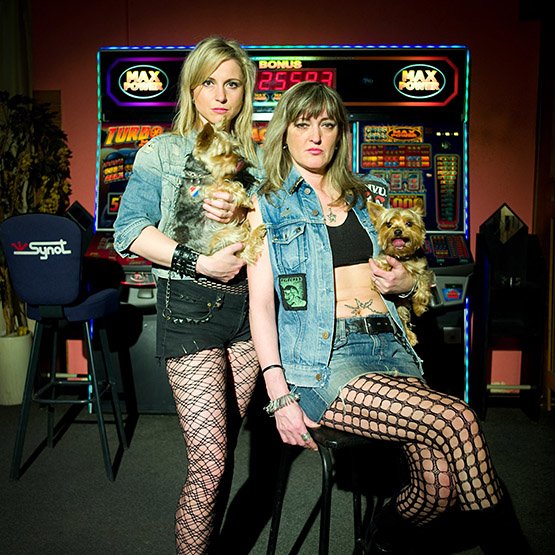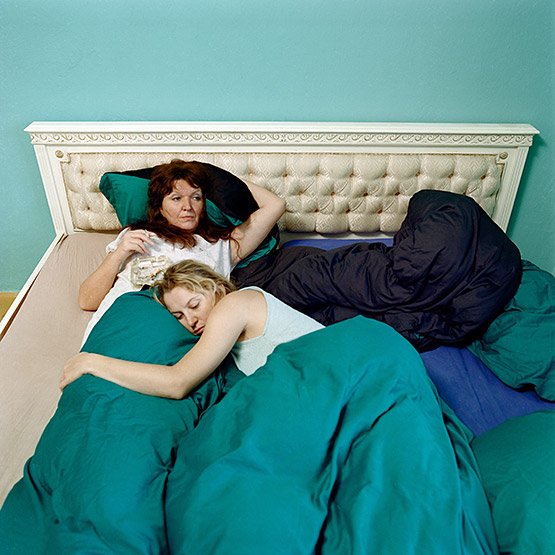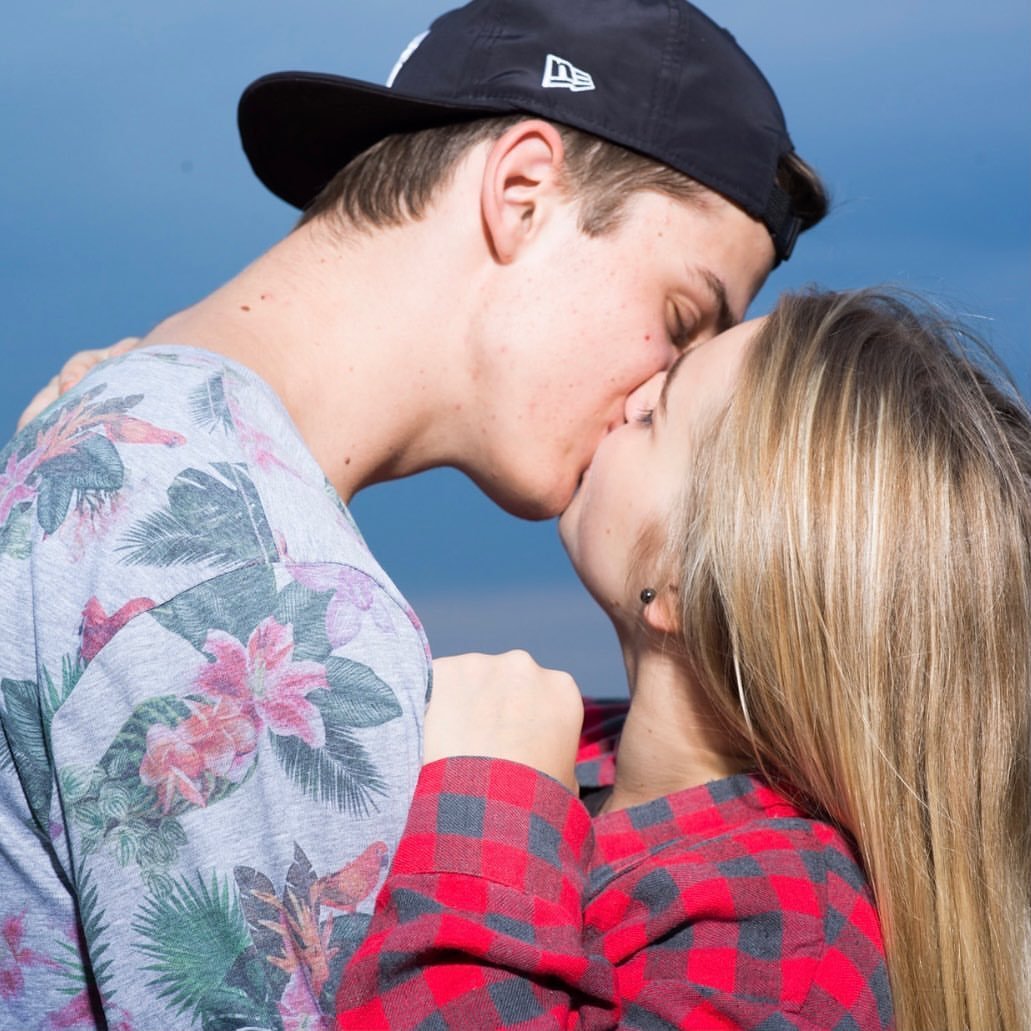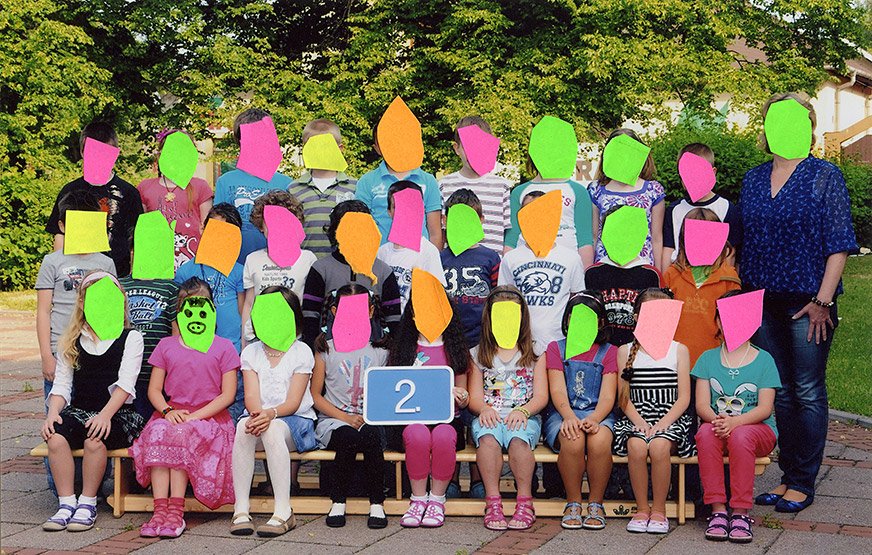Dita Pepe
A privilege much taken for granted is the documentation and access to one’s past. Regardless of socio-economic situation or geographical location, the possession of memories in a physical form of photographs helps to connect us to our lineage, as well as the past of those within our family unit. Faces are familiar, yet altered, as we recognize ourselves and others in moments pulled out of time entirely.
This is what makes the work of Ostrova born photographer Dita Pepe so enthralling, as the photographer situates herself within very real families in order to compose fictitious memories.
Often an invented sister or partner, Pepe repeatedly immerses herself into someone else’s life. Clothing, wigs, makeup, and even carefully emulated body language help to blend the photographer into the world she creates. A single face standing out within her body of work, we see her own life unfold with time.
Having started her ‘Self-Portrait’ Project in 1999, we see how over two decades of life have shaped her as both an individual and a creative. With an extensive collection of photography books published, each exploring femininity, intimacy, and the self, Pepe’s works are always rooted in the act of storytelling and connection. Intimacy captured within the shot speaks to a personal relationship and exploration with her subjects, as well as the unity inherent within their collaboration. It is no surprise that Pepe has been the recipient of so many Czech and International awards for her work, as you cannot help but feel heard and healed by the narrative she has developed throughout her career.
Hey Dita! How are you doing? What have you been getting up to lately?
I have been working on a new book, together with Jana Poncarová, so I have been reading texts and thinking about the whole concept. The book opens the topic of a creative place where Czech woman writers could work (it is inspired by Virginia Woolf).
That must be so exciting – I also love Woolf’s work and writing style. First of all, I just wanted to say that I love your work! I think the way in which you insert yourself (both stylistically and literally) within the composition of each photo makes your collection of works so beautifully intertwined.
Thank you, I am glad to hear it.
What kind of effect do you hope that this blurring between subject and author within your works has on your audience?
I feel a positive response to my work and it gives me strength to continue. I feel people are touched by my work – it speaks to them. The part when I share emotions with the people I photograph is extremely strong for me. They open to me, and it is almost like therapy. I often talk a lot to people before I start photographing them, and I feel their confidence.
In a way, it kind of feels like the performance of intimacy speaks to the viewer in a way that reminds them of their own relationships, or even just the potential of those emotions. I can imagine that with your “self-portraits” project, it must be so interesting to see both yourself and your family members adopting a new life for a moment. The way in which you commit to recreating the style, pose and dynamic within your performance of an absent family member helps to make you essentially an easter egg within your works, which I think is executed so wonderfully!
I see myself more like a fictitious member. I do not stand for an existing person from the family. It happens that there is nobody like me in the family or relationship. It is pure fiction.
What kind of impact do you think your body has on the overall dynamic between you and your surrogate family?
Body and facial expression, just as the whole pictured scene, contact of two or more people, type of light – all that has a meaning in the image. I have the possibility to talk to the people before shooting, I have their confidence and they are even ready to lend me their clothes for the image. All that mingles and creates an atmosphere where we can feel natural and good even beside apparent strangers.
Small children view it as a game – it is important to see that their parents are having fun and are doing something new, interesting and unusual… It is a kind of experience.
That’s so beautiful – to be able to become a member of a family and connect with everyone involved is just so genuine and exciting. I think regardless of whether it is explicit within the name of a project (for example, your INTIMACY series), there is this gentle vulnerability that always saturates your images. Whether it’s the color scheme you choose for the background, the poses, or the softness of the lighting, each picture feels like it is not only a snapshot from someone’s personal life, but it also holds a sweetness. On the more technical side of your work, how do you approach image composition in a way that communicates this so vividly?
I do not think much about the technical side. I used nothing but natural light coming from the window for my first successful photographs – no flash or artificial lights. The meaning of what I photograph is always more important to me. Aesthetic and composition come second. I like central composition, I prefer light images to dark ones, and I always look for naturalness when shooting people. I also want the people to feel good. Nowadays part of my work is created in cooperation with my husband Petr Hrubeš, who is also a photographer. He likes working with lights and it is a level which he puts into the photographs.
Also considering your role within the frame, being able to collaborate with your partner to add a different aspect to your works also adds a level of intimacy. I also really love the photos you’ve taken of your mother, and the way we see you slip into the role both fictionally and literally with the inclusion of maternity in so many portraits. How do you think your concept of maternity has changed throughout your photography career, and was there a specific experience while shooting that you feel might have influenced this shift? Maybe it was more of a personal experience outside of the work environment?
Before having my daughters, my mind was occupied with my own self, grandly said, with an idea of being an ideal woman. I did it intuitively, and my own desperation was the reason. I wanted to live differently than my parents. On my eighteenth birthday I ran away from home. I was looking for female examples, as I wanted to be stronger than my mum. That is why I started to create self-portraits – at first with different women, and then with men and families.
When I got pregnant, I thought it would mean nothing to me, as I am a creative person. I thought I would have the baby always with me in a sling and continue shooting without any change. I thought nothing could stop me.
However, everything was different after the childbirth. I became someone else. I was fascinated by everything that happened. I was breast-feeding all the time, lying in bed next to my daughter, nestling, smelling and observing her. Motherhood hit me completely. I had to fight with myself when it was necessary to leave our house and go out among people with her. This very intensive period subsided little by little – I breast-fed her until the age of three, and when my husband and I were shooting, she was always with us. Both my daughters are part of how I live, and I also have a very close relationship with my mum. It is of pivotal importance for me.
I think that evolution is so evident within your work, which is precisely why being a creative person can be so inspiring to others! You begin to track your own personal growth and development within the photographs, and people can feel that. Riding off of that last question, I know that Motherly Love is also the first chapter of your latest publication, Borders of Love. I think many people get catharsis from experiencing how others work through their own trauma, which is why this insight into ‘photography as therapy’ is such a deeply important (and once again, intimate) view into your own thought process. With other love-centered works published, what is it about Borders of Love which you feel really distinguishes it from your other bodies of work?
It is very open and specific. I dived deeply into my own self – it was uncomfortable and moving, but sometimes I also experienced feelings of euphoria when I saw the work is doing well and is of use. I also started to write for the first time in this book. It often happened to me in the past that when I was talking about my work, I felt it is important to say certain things and give the viewer context. When working on this book, I found out I can write too – or that it is readable, at least.
I think the addition of your own voice as an artist also helps an audience to better understand your own work, as well as give them a starting off point to relate the pieces to themselves. Thank you so much for taking the time to answer my questions! I’ve become completely enthralled in your work and can’t wait to see more from you! As my final question, I wanted to know if there is any specific country you would love to pursue a project in? I know you’ve been to Japan, Germany, Italy, and South Africa, but where do you feel there might be potential to explore another project?
I do not have a dream country. I feel I can do meaningful things even in my neighbourhood. People who are unbelievably inspiring for me live everywhere. However, I like to remember the nature and mentality of people from Australia, where I was working together with Bára Baronová on the book called Voices of Women.
interview ALIA AYOUBI
What to read next





























